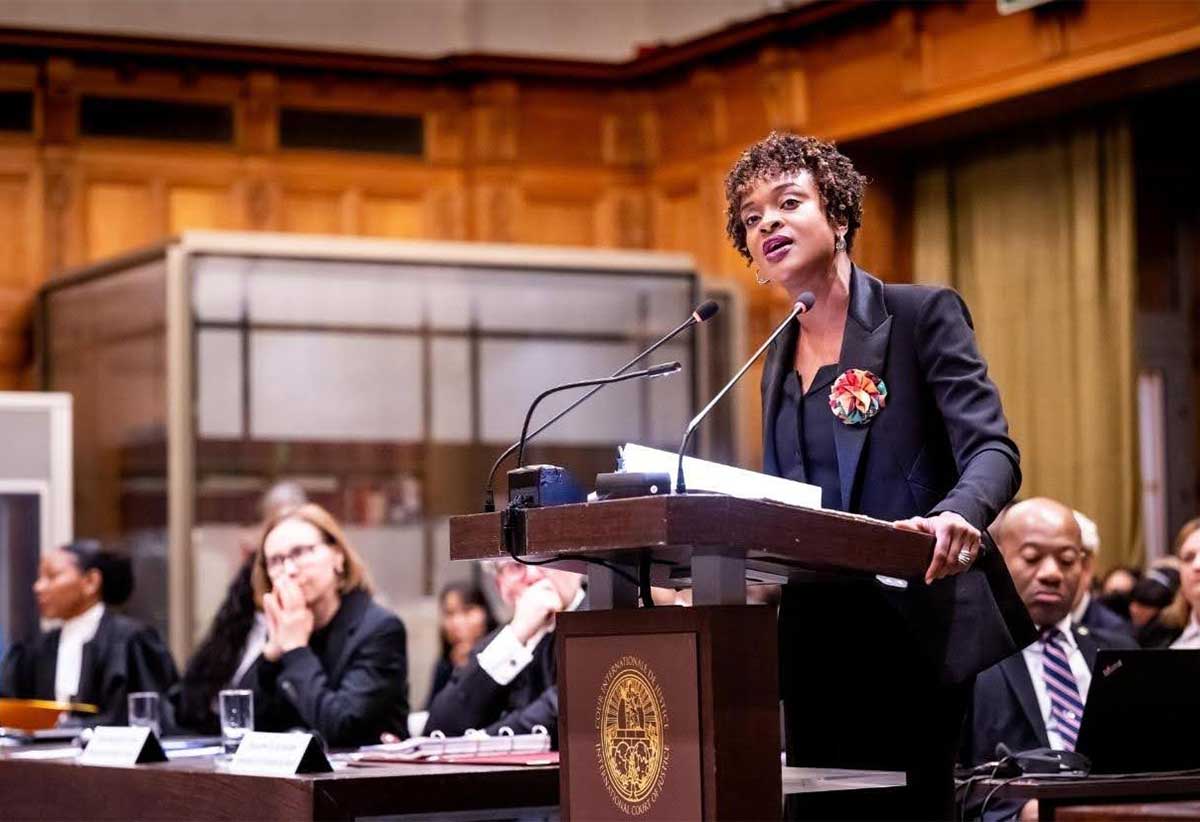Copyright thevoiceslu

1) Our Appearance before the ICJ On 10 December 2024, Chargé d’Affaires Desmond Simon introduced our delegation. The image of Helen appeared on the courtroom screens, returning at each transition. I opened. Wearing a rose madras corset over a black suit — a small, stubborn reminder of who we are — I began by introducing Helen and reminding the Court that this was Saint Lucia’s first appearance before the ICJ. We came not as spectators but as a large ocean State asking the Court to read the law where we live — in the sea, on the coast, in the markets and schools the ocean frames. I invoked my father’s village, Laborie, and the sea where he bathed as a boy — an ordinary memory now threatened by climate change. I urged the Court to speak in plain terms, because our destiny is interwoven with the fabric of humanity. I placed the science and Saint Lucia’s national evidence (Biennial Update Report, National Adaptation Plan, State of the environment) squarely in front of the judges, to show scale, pace, and disproportionate vulnerability. Ms Kate Wilson followed. She turned immediately to the legal architecture, taking square aim at the UK’s argument that climate treaties are the only lex specialis that matters, and that their “softness” should deter the Court from drawing harder lines. She countered that the UNFCCC and Paris Agreement bind States; they do not displace customary law. She stressed that the duty to prevent significant transboundary harm and the duty to cooperate remain in full force, reinforced by UNCLOS Article 194 on marine pollution. She also mentioned as applicable obligations contained in human rights treaties, including the right to a healthy environment referenced in the Paris Agreement’s Preamble, and the ongoing work being done through regional human rights treaties, like the Escazu Agreement. She pressed the Court to adopt the systemic integration we had argued in writing, reminding it that States owe stringent due diligence — all appropriate means, commensurate with risk, time horizons, and capabilities. Finally, Rochelle John Charles brought us home to consequences. She asked the Court to confirm the ARSIWA sequence — continue performing, cease wrongful acts, guarantee non-repetition, repair — and then translated these principles into a small island context. That meant ecosystem restoration (corals and mangroves), protection of coastal communities (Anse La Raye, Canaries, Dennery), water security, and early warning systems. It meant finance, technology, and capacity consistent with treaty obligations. And it meant ending contradictory policies, such as harmful fossil fuel subsidies. She connected these remedies to regional initiatives, especially the Bridgetown Initiative that proposes reform to the international finance architecture, noting that a remedy unfunded is a remedy unfelt. The Aftermath When we finished — last on the day — people we had never met stopped us in the corridor, congratulating us. It seems our strategy and attention to detail worked, because after our performance, Saint Lucia’s pleading was described as the “Taylor Swift concert of international law”, breaking the monotony of courtroom discourse with colour, passion, and clarity. One participant even told me, “I wanted to be Saint Lucian after I heard you all.” We took pictures with other delegations, thanked the Court staff, and walked out of the Peace Palace gates into the December cold with something I had not had before: the settled sense that we had done our best and had made Saint Lucia visible in a chamber where it had never stood. 6. The Court gives its Advisory Opinion (23 July 2025) — Did We Win? I remember exactly where I was when the President of the Court, Justice Iwasawa began to read the Advisory Opinion of the Court on 23 July 2025 — a mere seven months after oral pleadings. Swift by any measure of international dispute settlement, it was still enough time for us to steel ourselves for caution. And indeed, the tone was cautious. But the substance — 133 pages of it — was quietly decisive. We had been warned to expect restraint. Instead, we heard a Court that largely accepted our frame: read the whole house of international law together; let customary duties of prevention and cooperation do the heavy lifting; treat the UNFCCC and Paris Agreement as binding in content and ambition; and keep State responsibility (ARSIWA) on the table. Where the Court hesitated was on SIDS-specific consequences and the granular finance “bite” we had pressed. What follows is how the holdings map against what we argued in the Written Statement, sharpened in the Written Comments, and staged at The Hague — with Helen’s thread running through it all. 1) Method and Scope — A Whole House, Not a Silo From the start we had urged the Court not to box itself into the climate treaties. Reading the scope of applicable obligations broadly, we had argued that the climate treaties, UNFCCC/Kyoto/Paris, UNCLOS, human rights, and customary environmental law were all relevant. The Court agreed. It adopted systemic integration as method, guided by the Vienna Convention interpretative principles of good faith, objective and purpose, and effectiveness. Most powerfully, the Court emphasized that all fields of international law are implicated in the protection of the climate system — and was clear that other areas of law, including trade, investment, and finance were not excluded — music to my ears as a strong advocate of trade law. It even mentioned the discussions at the International Maritime Organization – a field that I also have taken up and where SIDS are part of discussions on maritime decarbonization under a proposed “Net Zero Framework”. It was a vindication of the broader vision we pressed: that climate change is not a silo, but a condition that runs through the full corpus juris. The Court also situated its reasoning in dialogue with other tribunals, citing ITLOS and the Inter-American Court, ensuring coherence across fora. 2) Science and Humanity — The IPCC as Anchor We led with science, and the Court followed. The Opinion leaned unapologetically on the IPCC’s Reports, including the Sixth Assessment Report for baselines and trajectories, including sea level rise and its existential risks. It declared climate protection “a common concern of humankind” and affirmed that States share “a common interest in the protection of global environmental commons like the atmosphere and the high seas.” It was also vindication of “science” as the baseline from which the Court would judge all legal arguments.



